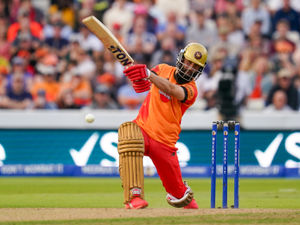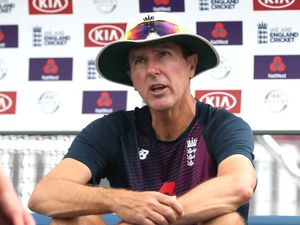Matt Maher: Back, at last, to hear the leather on willow
Anyone surveying the scene at Edgbaston on Tuesday would have been forgiven for thinking this was just a normal day at the cricket.
The seats of the vast bowl two miles south of Birmingham city centre contained a smattering of spectators, who soaked up the sun, ate their picnics and politely applauded any action worthy of it out in the middle.
Yet while the day undoubtedly had a leisurely feel, what we were actually witnessing was an important social experiment, a key step along the road toward supporters returning permanently to professional sport in the near future.
Warwickshire’s friendly with Worcestershire was chosen as part of the government pilot scheme and in doing so became the first event in the West Midlands to admit any spectators for more than four months. The importance of the day was summed up by the presence, in addition to 800 or so club members, of ECB chief executive Tom Harrison and Nigel Huddleston, the minister for sport. Alison McGovern, the shadow minister for sport, also made an appearance later in the day.
It was the ECB and government who first approached Warwickshire to see if they would be willing to take part in the pilot scheme. The Bears then had 10 days to prepare the ground and several hundred pages of risk assessments before the event was finally given the go-ahead by Birmingham City Council on Monday.
For Craig Flindall, the club’s chief operating officer, it has been a hectic few days yet also the kind of challenge he relishes.
“It has been a short timeline but it is testament to the team we have here at Edgbaston that everyone has pulled out all the stops,” he said.
“We are used to delivering big events.
“I knew when we made the call to our team asking if they were up for this what the response would be. We love innovation. We love being the first at doing things. To be one of only four venues across the UK doing these pilots is a great opportunity for us and the city.”
Even so, Flindall would be excused for feeling just a little more pressure than usual. Tuesday’s event was watched closely by many of his peers and yesterday morning he was scheduled to hold a conference call with a host of other stadium managers, from a range of different sports, all eager to know what worked well, what didn’t and what was learned?
In addition to putting in place the social distancing measures, signage and sanitiser stations now a common part of everyday life, the key focus of Warwickshire’s preparations was on ticket distribution.
Members were given the option of either one, two or three seats for people within their social bubble. Once selected, the club’s ticking software then put in place a two-metre bubble around those seats.
“Working out a new seating system is going to be a challenge for all sports stadiums going forward within socially distanced requirements,” said Flindall. “That is the area which has taken a lot of time.”
All attendees were required to provide an email address for test and trace purposes and commit to completing a health declaration. Tickets could be downloaded to a smart phone or printed off at home. That sounds straightforward, yet Warwickshire were also aware such processes aren’t always for a membership which tends to be drawn from older age groups. On Tuesday, there was also an element of common sense on display.
Once inside the ground, having entered through a designated gate, spectators were required to follow a one-way system and advised to remain in their seat as much as possible. They were also asked to remain inside the ground for the duration of the day and not to use local shops. Food and drink could be brought in, though no alcohol, cans or glass bottles.
The teams, meanwhile, were required to get changed at opposite ends of the ground. New rules means players must sanitise their hands every six overs.
“We’ve had to totally re-engineer the way we think about every aspect of staging sport, including player welfare, ticketing, access control, seating, concessions, toilets, parking,” said Bears chief executive Stuart Cain.
“Everything has been re-thought with social distancing and safety in mind. It has been a challenging but rewarding exercise.”
The number of spectators allowed will rise from 1,000 to 2,500 for the first two days of Warwickshire’s Bob Willis Trophy opener against Northamptonshire on Saturday and Sunday.
Another step in the right direction, as with everything else at the moment it requires a footnote of caution. As close to normal as things might feel, in reality they remain far from it. Until at least October, spectators to any sporting events will only be permitted in pilot schemes, making it likely most of the matches in September’s T20 Blast – domestic cricket’s most popular competition – will still take place behind closed doors.
“I think we have to be realistic and say the chances of having the kind of crowds we usually get for the Blast is unlikely,” said Flindall.
“Hopefully there will be more pilot matchdays. The long-term goal for the whole of sport and the whole of hospitality is to work toward having full crowds and full grounds in the medium term next year. We need to make sure we take baby steps. The last thing we want to do is push it and end up back at square one again.”
A baby step this might have been but it was also a welcome one, providing hope a little something can still be salvaged from a largely lost summer of sport.





